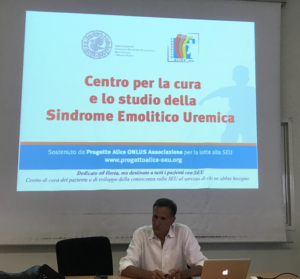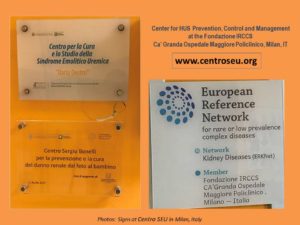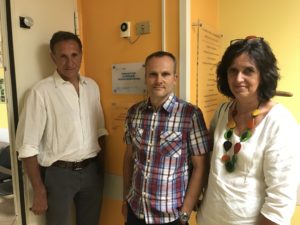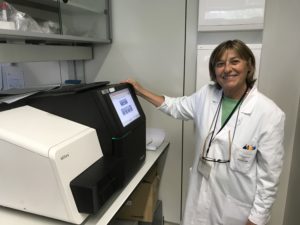The alliance reached its final stop on its Whistle Stop tour of four aHUS Expert Centres in Europe.

In the centre of the City of Milan is the Fondazione IRCCS Ca’ Granda Ospedale Maggiore Policlinico . In its Department of Nephrology is the Centro per la Cura e lo Studio della Sindrome Emolitico Uremica (Centro SEU). Established by Dr Gianluigi Ardissino who has worked at the hospital for over 30 years, the Centre focuses on both types of HUS. Centro SEU is recognised by the ERKNET as a Reference Centre.

The alliance delegates met Dr Ardissino in the children’s dialysis ward and he introduced his team, who worked some of their time on HUS related patient management and research. Their medical backgrounds varied from Nephrologists to Biologists reflecting their multi-disciplinary approach in what they do. Also present were aHUS affiliates from the Progetto Alice Onlus SEU, including its president Paolo Chiandotti. Progetto Alice has a very close relationship with the centre.

Our hosts for the visit
Dr Ardissino presented the background to the Centre and how it was the hub of a virtual network involving other parts of the hospital and other hospitals and specialists in the Region of Lombardy, The Centre also has as a national role in some of what it does. The Centro per la Cura e lo Studio della Sindrome Emolitico Uremica website at www.centroseu.org gives visibility to its activities to both clinicians and patients.

Over 800 referrals are made each year (with SEU/HUS sample carriage funded by Progetto Alice Onlus), and from these around 130 patients are found to have aHUS. A very high level of annual incidence, but one which is consistent from year to year. Centro SEU provides genetic screening (the patient organisation again providing funds for some of the equipment) in a new laboratory in another part of the hospital. Equipped with up to date DNA extraction machines it also has new generation equipment which can do whole genome sequencing ( it retains its Sanger Sequencing machine too).
Results are analysed, and advice is given for the management of each aHUS patients depending on genetic mutation found. The laboratory is also involved in search for new mutations of significance to aHUS. Centro SEU is another that has lodged the mutations it has found in the University College of London Complement variants database to help others.

The Centre’s team has had many research articles published and has delivered presentations at the top renal conferences. Perhaps Centro SEU is best known for the pioneering work over the past seven years on the withdrawal of patients from eculizumab treatment as well as the tailoring of dose levels and frequency to suit individuals needs to main safe levels of complement blockage.
Over 30 patients have withdrawn from eculizumab treatment each with different mutation and prior renal replacement therapy, including some with transplants. Over a third have relapsed and returned to treatment (some then withdrawing again) and others have remained in remission. On average the cohort has been eculizumab free for nearly four years. The decision to withdraw from treatment is made with each patient participating in the discussion before going ahead, learning about the risks and likelihood of disease recurrence. Dr Ardissino revealed that the default opinion he gives is that they are likely to re-onset. He is also of the opinion that it is with dosage amount adjustments and infusion intervals that economic use of eculizumab can be achieved at a level almost on par with the cost of dialysis and plasma exchange, but with significantly better outcomes and quality of life for the patients.
Once stable on treatment as measured by the blood samples taken during infusion visits the patients increase the interval between visits in steps up to 28-day infusion intervals as long as their complement activity remains at normal levels but if not, the interval may be adjusted. All patients at the centre are currently at 28 days intervals. All patients are expected to self-monitor using urine dipsticks and a rapid return to treatment protocol is followed if the patient finds a positive result in their test wherever they may be in Italy. Of those who have relapsed the difference in their kidney function is more or less the same as it was on their last test before recurrence.
Another way in which waste of the drug may be avoided, particularly in adults , is to adjust dosage downward depending patient weight. No patient is currently on four vial infusions.
The trials of dosage volumes back in the day when they were done needed to have a large margin for safety and needed to be at a high level to ensure no breakthrough of the disease happened to demonstrate its efficacy. aHUS and PNH (where adults would typically only have received 75% of the adult aHUS patients dose) are different diseases with perhaps a wider spectrum for aHUS because of the trigger and other complement mutations making each patient different and needing a patient by patient approach.
As mentioned earlier the patient organisation has a close partnership with Centro SEU having formed over ten years ago , so preceding the centre’s creation , so it has long association with it. Progetto Alice are supportive of the personalising of treatment and said patients were appreciative of the way the centre speaks to them and as a result there is a high (“99%”) positive atmosphere about the place.
Although not all research done by Dr Ardissino is on aHUS he has much of his work published, and has presented at international conference. He illustrated the diversity of his work with examples of his findings not only on withdrawal and dosage tapering , but also for example the subject of aHUS and bone marrow stem cell transplant where he has found disease predisposing genetic mutations in the donors in a significant number of a small cohort of BMTx aHUS patients.
The alliance was grateful for the time afforded to the delegates during the visit and the participation of our affiliates from Italy.
The visit to Milan concluded our 2018 Whistle Stop tour of four aHUS Expert Centres in the EU, and this news item is the last in this series. However, the alliance has gathered a lot of data about the characteristics of aHUS Expert Centres which it intends to publish on in due course. This would be probably be the first attempt to describe the concept of a rare disease expert centre in the context of a single disease. Such a project would take some time but eventually it will bring this excellent experience to an appropriate end.

Whistle-Stop Tour of 4 aHUS Centers in the EU: Visits to Three Nations in 6 days (July 2018)
1st Stop: Paris FRANCE
2nd Stop: Newcastle upon Tyne ENGLAND (UK)
3rd Stop: Bergamo ITALY
4th Stop: Milan ITALY

